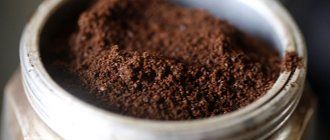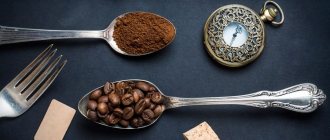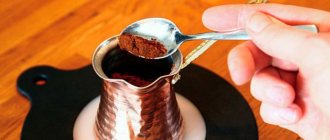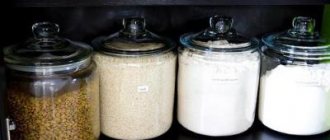Useful and harmful qualities of caffeine
If you drink in small quantities, it can have a positive effect on the human body. Caffeine in small doses increases physical and mental activity and improves mood. People involved in intellectual work, if they drink two cups a day, notice that they cope with tasks faster than their colleagues who do not drink this invigorating drink. American scientists have proven that caffeine is an excellent stimulator of neural activity, but it should not be abused frequently. Natural alkaloid (caffeine) can negatively affect health, especially for people suffering from gastritis, cardiovascular diseases, insomnia, and nervousness.
Caffeine is found in plants such as the coffee tree, tea, cocoa, mate, guarana, cola and some others.
Let's compare and draw conclusions

Let's compare the numbers and draw conclusions. Espresso coffee contains the highest percentage of caffeine. One saving grace is that the usual portions of this drink are very small, approximately 30-40 mg. Therefore, in order to get too much caffeine while drinking espresso, you need to drink almost ten cups of this drink in one sitting. There are probably such originals, but most coffee lovers prefer to make do with just one cup. Therefore, it is this variety that contains the least alkaloid in one cup - despite the overall percentage. The cups are just very small. This is the paradox.
How much caffeine per day is not harmful to a person?
This norm has been known for a long time. Of course, it is average, taking into account the characteristics of the person himself: his age, health, gender, lifestyle, etc. But, however, when drinking coffee regularly, this norm should always be kept in mind - regardless of who exactly drinks this drink.
So here it is. The average amount of coffee drunk per day should be no more than two standard cups. Three at most. And, say, pregnant women should not drink more than one cup during the day. Otherwise, it will harm both the woman herself and the unborn child.
How much caffeine is in different varieties
Coffee is like grapes - its taste depends on the composition of the soil in which it grew, climate, and growing conditions. The same variety can change its taste and aroma depending on the degree of roasting and grinding. Today, the Robusta coffee variety is the leader in terms of high caffeine content. Alkaloid levels reach 2.2%. If we compare it with Arabica, it contains only 1.2%.

Caffeine is one of the most widely and regularly consumed natural biologically active compounds, known since ancient times.
The level of caffeine cannot be determined by the taste, aroma, or bitterness of the drink. It is not possible to determine the amount of natural alkaloid using the senses. If the beans have been heavily roasted, the strength of the drink will be lower. This is due to the chemical process involved in roasting the beans. When heated during roasting of beans, the molecules of the stimulating substance are destroyed.
Caffeine and coffee varieties

As you know, there are many varieties of coffee. And each variety has its own dose of caffeine. This is very important to know for coffee lovers who are prone to abusing this drink. If someone cannot live without coffee, then, in any case, it is better for him to drink cup after cup of varieties that do not contain so much alkaloid. Otherwise, a “coffee overdose” can easily happen with all the ensuing sad consequences.
So, which types of coffee have more caffeine, and which ones have less? Let's consider this question in more detail based on the same ordinary cup of drink:
- in classic ground coffee there is about 190 mg of alkaloid;
- espresso – approximately 75 mg of caffeine;
- in Americano – 50-70 mg of alkaloid;
- in cappuccino – also from 50 to 70 mg of caffeine;
- in latte there is a little more of it - from 50 to 90 mg;
- in glass - about 65 mg of alkaloid.
Separately, it should be said about the caffeine content in the most popular drink today - instant coffee. It is known that instant coffee is produced and, accordingly, sold in the form of granules or powder. Preparing it is as easy as shelling pears. Pour hot water over the powder or granules, and you're done.
But this is not the only reason why instant coffee is so popular. For some reason, it is generally accepted that since this product is processed in such a significant way, then by definition it cannot contain harmful caffeine. This means that instant coffee is the healthiest of drinks.
This is where the mistake lies. There is also enough caffeine in instant coffee. It is made from low-grade robusta, and this type of coffee bean contains more than enough caffeine. Accordingly, a lot of it remains in the finished product - instant coffee. Where should he go?
Rating by amount of caffeine
The most caffeinated beans grow in certain geographic locations. The well-known Arabica variety, brought from South America, a drink rich in taste and aromatic qualities, may not be at all strong. Brazilian and Colombian varieties lead the world market. The drink from these countries has medium strength and a mild taste. Beans from the Middle East and Africa have the highest levels of caffeine.
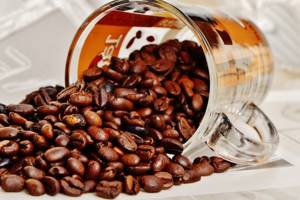
Caffeine gets its name from one of its main sources - coffee beans.
Robusta contains the most caffeine
It has a second name - Congolese. It contains the highest amount of caffeine from 2 to 4%. The taste of this drink is rich and the aroma is pronounced. It is consumed in a mixture with other varieties due to the presence of bitterness, but this drink is also popular in its pure form. Robusta translates to “strong.” And this name fully corresponds to it - it can germinate where Arabica does not take root.

Robusta is the default commercial coffee
When this variety grows, its leaves are large and its flowers have a white-pinkish color. The grains ripen up to 12 months. They are larger in size than Arabica beans by 5-7 millimeters. Those who have tasted it note the bitterness in the taste of the drink. However, there are connoisseurs of this coffee - tart, bitter and even spicy.
Monsoon Malabar
One of the varieties of Arabica is unlike any other variety. The coffee does not have bright richness, sourness or fruity notes. Despite its “smooth” taste, Malabar is memorable, with its own twist. This coffee taste is often found in the East in the countries: Egypt, Turkey, Greece and Israel.

The harvested coffee beans are exposed to monsoon rains and winds for three to four months, causing them to swell and change their flavor characteristics.
The monsoon drink acquired such a taste thanks to a unique processing technology. According to legend, when Europeans arrived in India, they supplied coffee to their ports. The grains took months to reach Europe and had time to become damp due to humid monsoon weather changes. The grains became yellow in color and changed their taste. In southwest India these days, this technology for aging grains is used in specially equipped warehouses.
Sulawesi Thoraya
Indonesian Sulawesi Toraja is freshly roasted coffee beans, which produces a strong, aromatic drink with a fruity flavor and a high content of natural invigorating alkaloid. The artificial aging technique is used for this variety, as with the previous monsoon Malabar.
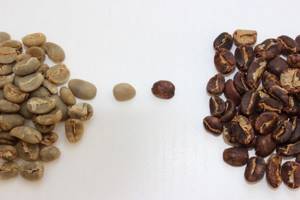
Coffee from the island of Sulawesi has a wonderful aroma and rich bouquet
Kubito
The name of coffee varieties brought from Cuba. The content of natural alkaloid in them reaches 2.5%. The qualities of the drink from Cuban freshly ground grains acquire a fruity note, a tart, burning taste and a rich aroma. The Cuban drink is usually drunk from small cups - this is enough to cheer you up.
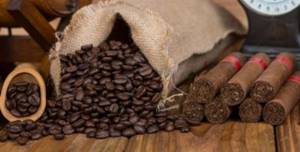
Beans and ground Cuban coffee of elite varieties
Yemen Moko
The African strong coffee variety was one of the first brought to Russia. 100% Arabica beans are also prized by drink lovers around the world. Yemen Moko is grown in northern Africa at an altitude of 200 meters above sea level. The grains are collected by hand and dried on the roofs of houses. The harvest is low, up to 8 thousand tons of grains, so the price for Yemen Moko is high. Its unique taste is unlike any other. You can feel fruity and wine notes in it.
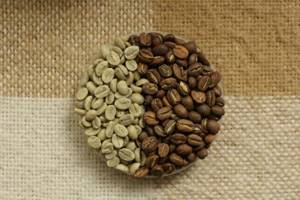
Yemen is home to some of the best coffee in the world.
Table of caffeine content in natural coffee in mg
Approximate caffeine concentration per 200 ml coffee:
- Mocha Ethiopian and Santos 189 mg;
- Costa Rica and Peru 200 mg;
- Arabica up to 210 mg;
- El Salvador and Guatemala up to 220 mg;
- Meleber and Colombian varieties up to 230 mg;
- Varieties from Haiti 235 mg;
- Robusta from 380 to 400 mg.
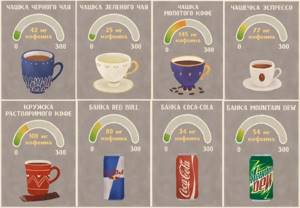
Caffeine content in different drinks
How to reduce caffeine in a cup of coffee
To reduce caffeine levels, use the following recommendations:
- Make coffee in a Turk. The caffeine content will decrease by 20-30%.
- Drink coffee with milk or lemon. Minus 10-20% to the strength.
- Use Arabica for cooking. It has at least 10-15% lower caffeine content than in mixtures and blends.
We remind you that 300 mg of caffeine per day is considered a safe dose for humans. With regular coffee consumption, as a rule, the safety threshold increases. However, according to the latest scientific data, a person’s reaction to coffee is determined at the genetic level, therefore the permissible amount of caffeine varies according to individual characteristics.
Amount of caffeine in one cup of instant coffee
This coffee contains a natural invigorating alkaloid, but there is not much of it. By the way, strong black tea is stronger than instant coffee. Ground real coffee can contain up to 4% caffeine, but it is almost impossible to find such a product on supermarket shelves. When producing ground coffee, a strong coffee concentrate is sprayed into a chamber filled with nitrogen. The drops freeze on the fly and coffee granules are formed. They contain up to 45 times more caffeine compared to ground coffee. Synthetic caffeine can be more energizing and energizing than coffee blends or Arabica coffee. Also, unscrupulous manufacturers may mix ground coffee with chicory.

The discovery of coffee dates back to approximately 850 AD. e.
Reducing caffeine content
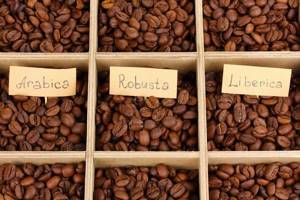
Despite all the stories and warnings from doctors, most coffee lovers cannot give up their favorite drink. To minimize its harm, there are a few neat tricks you can learn to help reduce the concentration of caffeine in your cup of drink.
Advice! Give preference to Arabica coffee. Initially, its beans contain less caffeine compared to Robusta.
If you want to completely minimize the consumption of this plant alkaloid, give preference to decaffeinated raw materials or green beans that have not been roasted.
It is better to prepare ground roasted coffee in a Turkish coffee pot than in a coffee machine or other methods. There will be approximately 10% less caffeine in coffee if pasteurized cow's milk or cream is added to it.
On a note! Lemon has the same properties as milk. Literally one slice is enough to reduce the concentration of caffeine.
Decaffeinated ground and bean coffee
Coffee that has been processed to remove the natural alkaloid caffeine is called decaffeinated. It will not be possible to completely remove caffeine from the drink to preserve its taste and aroma, but it will contain a small amount of it. As a result, the percentage of caffeine in 200 ml of drink will be only 0.1% or 80-100 mg. The benefit of this coffee is that it can be drunk by people for whom caffeine is contraindicated. Diabetics, pregnant women, and people with heart and vascular diseases can afford one or two cups of decaffeinated coffee.

Initially, not a decoction of roasted beans, but directly raw coffee berries were used as a tonic.
How to replace coffee when giving up caffeine
The most common way to replace your usual cup of coffee in the morning is black leaf tea. The tonic component in this drink reaches up to 80 mg. But in tea, caffeine is in a bound state, and in coffee it is in a free state, which explains the tonic effect. Green teas are no less saturated with caffeine - 90 mg of caffeine per 300 ml of drink. You can achieve the effect of vigor and enhance brain function by drinking 3 cups of black or green tea. Invigorating products also include: ginger, cocoa, ginseng, chicory, masala 380 to 400 mg.
Caffeine has scientifically proven advantages and disadvantages, as well as side effects. If you drink no more than three cups of strong coffee a day, it will not cause harm to your health.
Coffee connoisseurs will also be interested in learning about the preparation of mochaccino, amaretto, mocha and raff coffee. Coffee with cola, marshmallow and fashionable frappuccino will surprise you with their unusual taste. And lovers of the classics will like espresso, Irish and Viennese coffee.

Where is there more caffeine?
Processed grains and leaves can have completely different effects on the body, depending on the presence of additional impurities and the individual characteristics of the person. Identical numbers on paper do not guarantee an identical effect, because the consumer’s reaction will depend on many factors. For example, brewing time, quantity of mixture and quality of product.
If we compare the amount of caffeine in tea and coffee, the second option will always be more saturated with invigorating microelements. If your goal is to quickly increase activity (physical and mental), then we recommend using a more intense option. To raise your tone for a long time, you can hold a tea ceremony. In addition, this minimizes the risk of exceeding the therapeutic norm.


